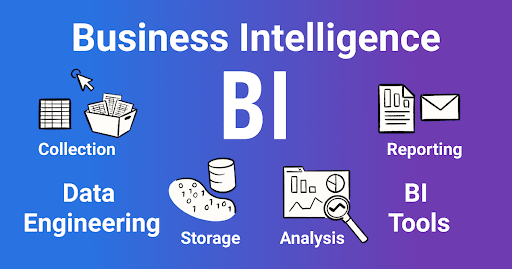Software known as business intelligence (BI) ingests trade data and displays it in logical ways such as reports, consoles, charts, and graphs. Business clients can now access a variability of data types, counting semi-structured and shapeless data, such as social media, as well as ancient and current data from both inside and outside sources. Users can observe this data to learn more about how the company is doing. Business intelligence (BI) isn’t just about making reports, according to CIO magazine: “Although BI doesn’t advise business users what to do or what will happen if they adopt a given course, BI is also not only about producing reports. Instead, BI provides a means for people to analyze data in order to recognize trends and draw conclusions.1
Businesses can utilize the knowledge they acquire from data analysis and business intelligence to make better business decisions, recognize difficulties or problems, identify market trends, and discover new sources of income.
Types of business intelligence tools and applications
In order to address much material needs, a eclectic variety of data analysis applications are joint in business intelligence. Most are maintained by both customary BI systems and self-service BI tools. The following are some of the BI technologies that are accessible to organizations:
This is sometimes referred to as ad hoc querying, and it is a fundamental component of self-service BI tools as well as modern BI applications. It is the procedure of generating and executing queries to exploration specific business problems. Although ad hoc queries are frequently made on the spot, they frequently end up being executed on a regular basis, with the analytics findings being included in dashboards and reports.
What are some examples of business intelligence use cases?
Enterprise BI use cases generally include the following:
- monitoring business presentation or other types of metrics;
- supporting decision-making and strategic planning;
- evaluating and improving business processes;
- providing employed workers with caring evidence about customers, machinery, supply chains, and other business procedures; and
- Detecting trends, patterns, and dealings in data.
Industry-specific use cases and business intelligence applications differ. For instance, risk analysis is carried out by financial services companies and insurers using BI during the loan and policy approval processes.
And to use existing client portfolios to determine what new goods to offer them. While manufacturers rely on BI for historical and real-time monitoring of plant operations and to assist them manage production planning, procurement, and distribution, retailers use BI to handle marketing campaigns, promotional planning, and inventory management.
Business intelligence vs. data analytics and business analytics
The phrase “business intelligence” has been used sporadically since at least the 1860s, but consultant Howard Dresner is credited with coming up with the term for the first time in 1989 as a general term for using data analysis methods to help business decision-making processes. Early analytics technologies, which were frequently mainframe-based, such as executive information systems and decision support systems, which were largely utilized by company executives, gave rise to what is today known as BI tools.
Business analytics and business intelligence are occasionally used interchangeably. In other contexts, the term “business analytics” is either used more generally to encompass both BI and advanced analytics or more strictly to refer to BI. Data analytics, on the other hand, is a general word that refers to any BI and analytics solutions. That covers the three primary categories of data analysis: prescriptive analytics, which suggests specific business actions, predictive analytics, which forecasts future behavior and consequences. Descriptive analytics is often what BI gives.
Business intelligence trends
Business intelligence teams typically include of BI managers as well as a mixture of BI architects, BI developers, BI analysts, and BI specialists that collaborate closely with data architects, data engineers, and other data management experts. To represent the business side and ensure that its demands are satisfied, business analysts and other end users are frequently also included in the BI development process.
To help with that, an increasing number of businesses are switching from traditional waterfall development to Agile BI and data warehousing methods, which use Agile software development techniques to divide BI projects into manageable pieces and deliver new functionality incrementally and iteratively. By doing this, businesses may implement BI features more quickly and fine-tune or alter their development strategies in response to shifting business demands or new specifications.
Business intelligence vendors and market
Today’s BI software must have self-service BI and data visualization capabilities as a minimum requirement. By early adopting self-service technologies, Tableau, Qlik, and Spotfire—now a part of Tibco Software—became significant competitors in the BI market by 2010. Since then, the majority of manufacturers of conventional BI query and reporting tools have taken their lead. Nowadays, self-service features like ad hoc querying and visual data discovery are included in almost every major BI application.
Modern BI platforms also frequently come with the following features:
Tools for creating BI dashboards, reports, and performance scorecards that display visualized data on KPIs and other business metrics;
Data storytelling features for fusing visualizations and text in presentations for business users;
Usage monitoring, performance optimization and security control.
Benefits of business intelligence
A successful BI programmer results in a number of organizational business advantages. For instance, BI enables C-suite executives and department managers to continuously monitor business performance so they can take swift action when problems or opportunities present themselves. Marketing, sales, and customer service efforts can all be improved with the support of customer data analysis. Bottlenecks in the manufacturing, distribution, and supply chains can be found before they endanger the economy. HR managers are better equipped to keep an eye on workforce statistics including labor expenses and staff productivity.
The following are some of the main advantages that firms can gain from BI applications:
- hasten and enhance decision-making;
- streamlining internal corporate procedures;
- improve productivity and operational effectiveness;
- identify issues with a firm that needs to be fixed;
- recognize new market and business trends;
- create more effective company strategy;
- increase sales and bring in new revenue; and
- Obtain an advantage over competing businesses.
Why business intelligence is important.
Administrations can use business intelligence to ask questions in basic language and accept clear replies. They can base results on what their company data is saying them, whether it tells to manufacture, supply chain, customers, or market trends, rather than trusting best assessments.
Why are sales in this area declining? Where is our extra inventory located? What are consumers saying about brands on social media? BI aids in addressing these important queries.
In his IBM cloud computing and business intelligence blog, Maamar Ferkoun writes, “Business intelligence provides past and current insights into the business.” This is accomplished through a variety of tools and techniques, from reporting and analytics to data mining and predictive analytics. BI gives a company the ability to create a business strategy based on real data by giving a precise image of the firm at a given time.
How does business intelligence work?
Data storerooms have always helped as the foundational basis of information for BI tools. A data warehouse chains information from several sources into one main database to facilitate journalism and business analytics. The warehouse is queried by business cleverness software, which then shows the findings to the user as reports, charts, and maps.
On analytical processing (OLAP) engines can be added to data storerooms to grip multidimensional queries. For instance: How have sales changed this year compared to last year in our eastern versus western regions?
According to IBM product manager Doug Dailey on his data warehousing blog, “OLAP provides powerful technology for data discovery, facilitating business intelligence, complex analytic calculations, and predictive analytics.” The stability of data and calculations that OLAP employs to push data to recover product quality, customer communications, and process progresses is one of its key advantages.
While some more current business intelligence explanations may quotation and ingest raw data directly using tools like Hadoop, data warehouses are still frequently the preferred data source. A
Conclusion
When and where individuals need information, BI software connects them to it. It also proposals abilities much beyond worksheets to current a accurate view of the business. Finding a BI strategy, however, that fits their resources, experience, and budgets can be particularly difficult for small and mid-size businesses.
—Gartner, How to Conduct Successful Business Intelligence: A Step-by-Step Guide
When implementing BI, organizations frequently start out small by producing ad hoc reports or reacting to business events. This reporting frequently uses old data. Moving past that, though, is a distinct possibility.
Organizations can eventually start utilizing data to forecast outcomes. When it comes to leveraging data to recognize consumers’ impersonations as well as the general position of the organization, “the sky is the limit” thanks to big data, mobile Computing, internal data warehouses, and the cloud. Making meaningful BI is a fluid aim that needs to adjust as new data become available and organizational requirements shift.
BI is not exclusively the duty of the IT division. It habitually initiates that way, but it must adjustment. Although IT may concentrate on the storage, processing, and dissemination of BI, IT must collaborate with the business stakeholders who produce, comprehend, and utilize the intelligence if BI is to be truly beneficial to your organization. Although technology may have enabled BI, it is a tool used by business to improve knowledge of the situation. BI is not just a tool for the IT department.





